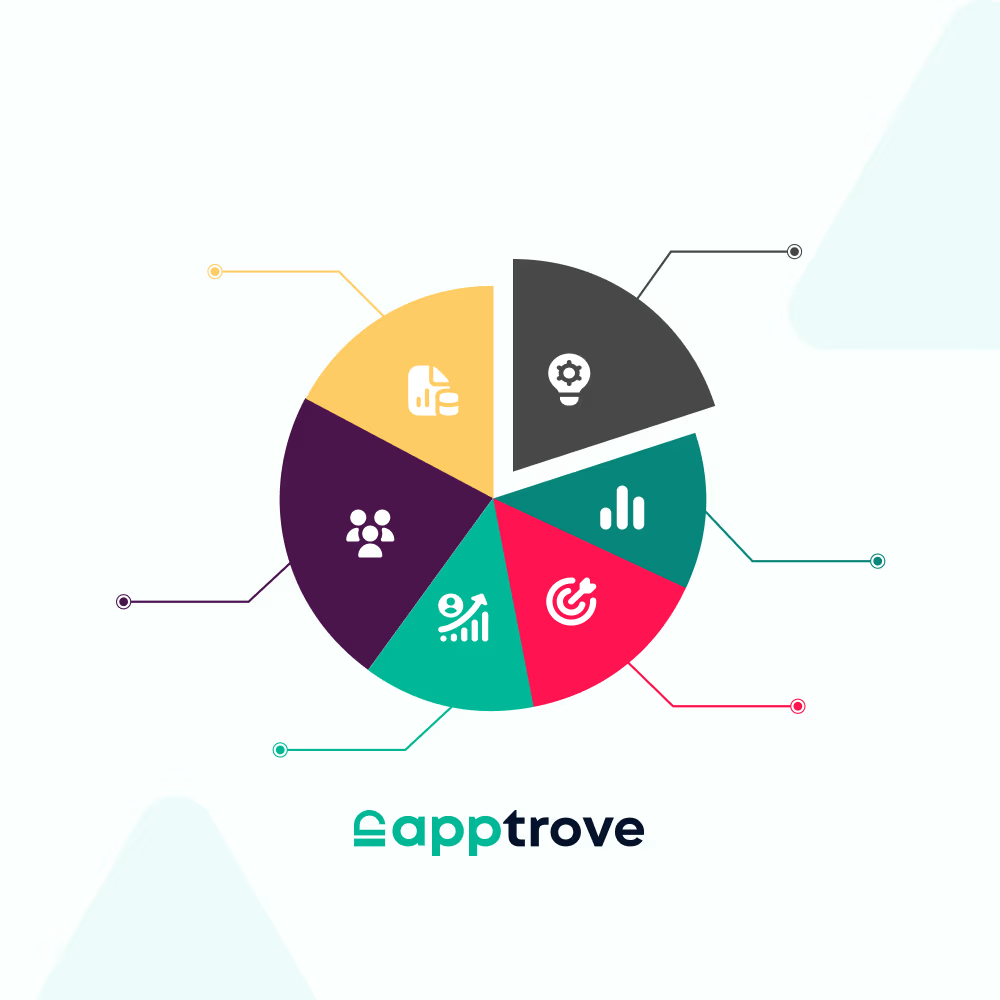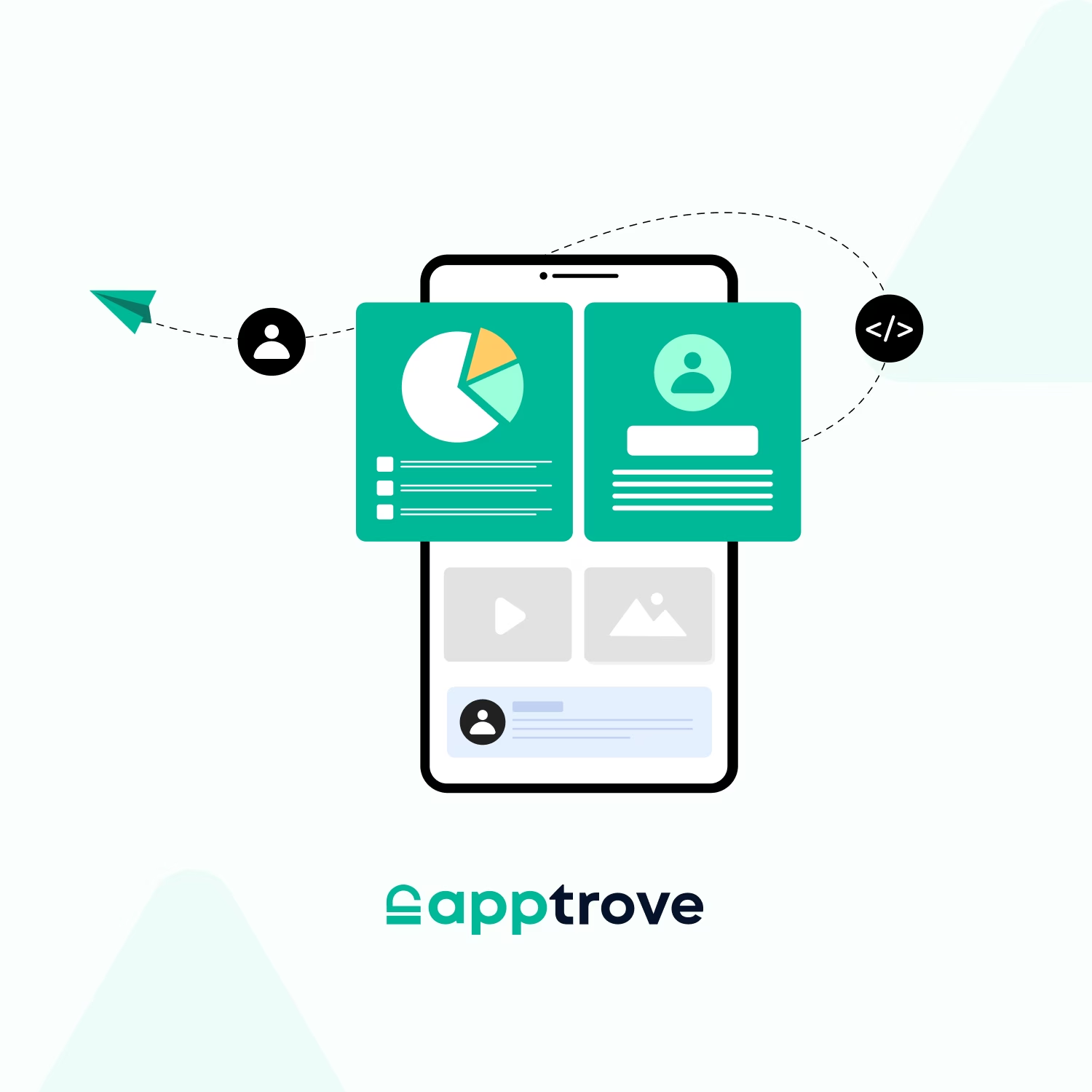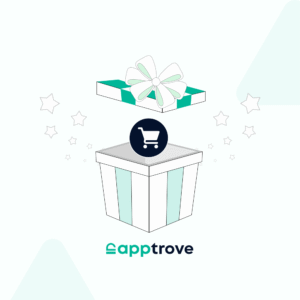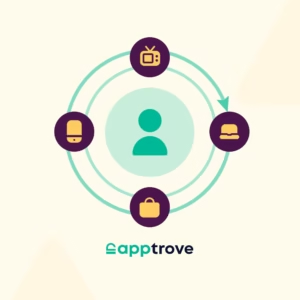The concept of marketing no longer requires the approach of trying to reach as many people as we can it now requires that we are reaching the right people. The user is overwhelmed with applications, notifications, and advertisements and it is unreal the number of stimuli they have to endure per day — in fact, the average person is exposed to between 4,000 and 10,000 ads daily. Segmentation has become the key to effectiveness, as it means dividing your audience into recognizable segments based on behaviors, preferences, or market characteristics. These behavioral segments are not only interests, but actionable insights to bring the relevant, personalized and impactful marketing experience to them.
With customer segmentation, market segmentation, behavioral segmentation, and demographic segmentation, you do not have to create campaigns that are necessarily generic in nature — you can build experiences that feel unique and intentional instead of relying on hoping there will be engagement. Segmentation gives you the power to guess what users may need, so that you can be better prepared for their behavior or design campaigns that resonate deeply.
This guide will take you through every step in the theory and practice of segmentation. You will learn how to build meaningful segments, how to design an actionable segmentation strategy, and lastly, how to measure success in generating growth, retention rate, and revenue. You will end with a process to convert raw user data into insights that drive your marketing in a well-thought-out way.
Why Segmentation is a Game-Changer for Your Marketing
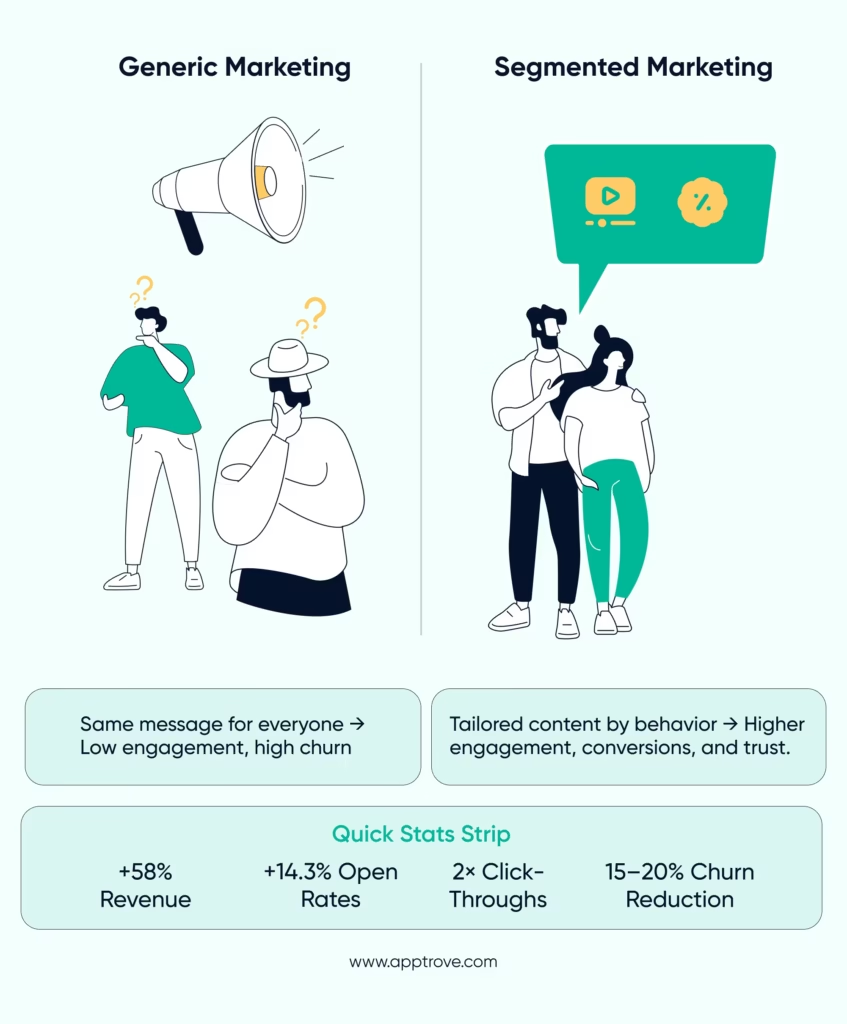
Think about sending the same push notification to every user on your app. A small percentage might click it, some may ignore, and others may be uninterested. Now consider an alternative: each user receives messages that align with their unique interests, behavior in the app, and interaction sequences. This is quite a difference, which is why segmentation is valuable. Segmented email campaigns generate 58% more revenue, improve open rates by 14.3%, and double click-through rates compared to non-segmented ones.
Segmentation allows for an incredibly detailed understanding of your audience. By dissecting your audience’s behaviours, motivations, and preferences, you can send messages, features, and experiences that feel like they were designed specifically for them. It’s not just about increasing a click-through rate or overall conversion rate; it’s about fostering interaction that drives commitment and trust.
There are multiple areas of growth by segmenting your audience:
- Engagement increases because you are talking directly to the user’s needs.
- Churn decreases because you are able to identify and reach out to groups at risk—and segmentation has even been shown to reduce churn by 15–20%.
- Conversions are increasing, and your targeted campaigns are going directly to those users who are much more likely to take action.
- Optimization is always happening because your decision-making is based on data.
As an example, if you notice that a group of users or a segment frequently engages with video tutorials, you’ll want to create campaigns that highlight interactive video content for similar users. In a similar fashion, identifying behavioral trends in purchasing, or feature usage, can point you to high-value segments, and you’ll want to create premium offers or rewards programs.
Segmentation removes the guesswork and gives you insight into action. You can utilize observable trends rather than broad assumptions to create targeted campaigns that are driven by real-time data. More accurate information allows you to allocate resources and develop a strategy that puts your marketing budgets towards media that have a relevant and measurable impact.
Acknowledging Customer and Market Segmentation
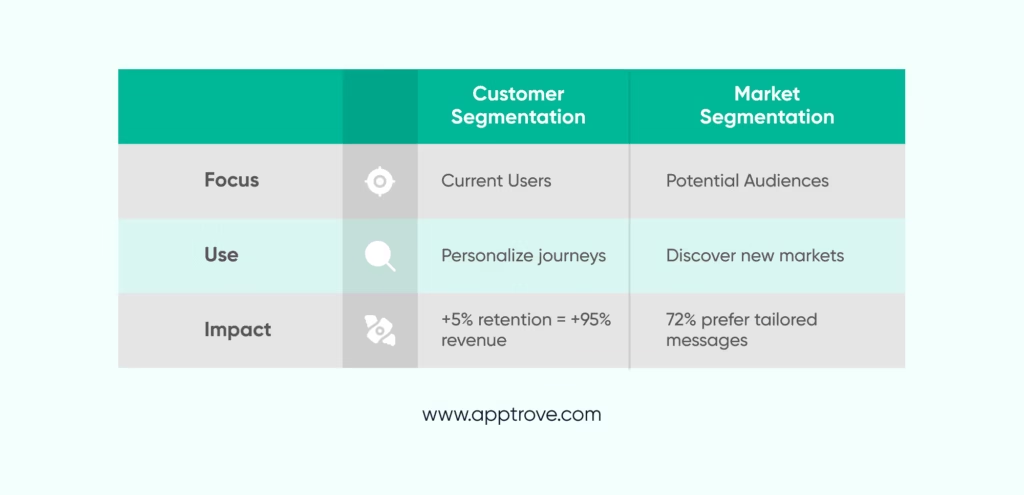
Segmentation is fairly esoteric until you get to the basics of the two forms of segmentation: customer segmentation and market segmentation. They both segment your audience and are strategic, but serve two different purposes.
Customer segmentation is concerned with your existing users. By segmenting existing users into their individual behavior, preferences, and demographics, you can quickly understand how to deliver the user experiences fitting each user’s journey stage. Whether it be onboarding, retention, upselling, etc. Customer segmentation allows you to deliver the right experience at the right time. Even a modest 5% boost in customer retention can increase revenue by as much as 95%, because retaining existing customers costs far less than acquiring new ones.
Market segmentation looks to the broader audience beyond the current user base. It finds unique groups of people based on geography, industry, or some other characteristic, and will give direction regarding acquisition strategies & provide clarity on the product position. Understanding market segmentation allows you to allocate resources in the best way possible while identifying further markets to grow into, 72% of customers only engage with messages tailored to their interests.
Customer Segmentation
Customer segmentation is all about identifying patterns across your user base. Some users may care more about social engagement, while others emphasize in-app purchases. Knowing these patterns allows you to create campaigns and product experiences customized to the preferences and needs of each segment.
For example, if users who went through a tutorial also frequently purchase, you can create campaigns that encourage new users to onboard in the same way. Optimize engagement and conversion by segmenting based on user behavior like this.
Segmentation also allows for resource allocation. Once you’ve identified your high-value users, you can channel retention campaigns, upsell, and personalize offers where you believe they will have the most impact.
Market Segmentation
Market segmentation allows an analysis of external opportunities to separate audiences into different groups by industry, geography, or potential customer group. This allows for targeting, better resource allocation, and improved messaging.
For example, if different geographies have varied trends of adoption, you may find underserved markets with good potential. More to the point, you might find it easier to understand which industries are more likely to adopt your App to best target acquisition campaigns and position the product. Gathering market segmentation insights means all efforts should be spent in the areas that will drive the best return vs a shotgun approach.
Examining Behavioral Segmentation for Better Targeting
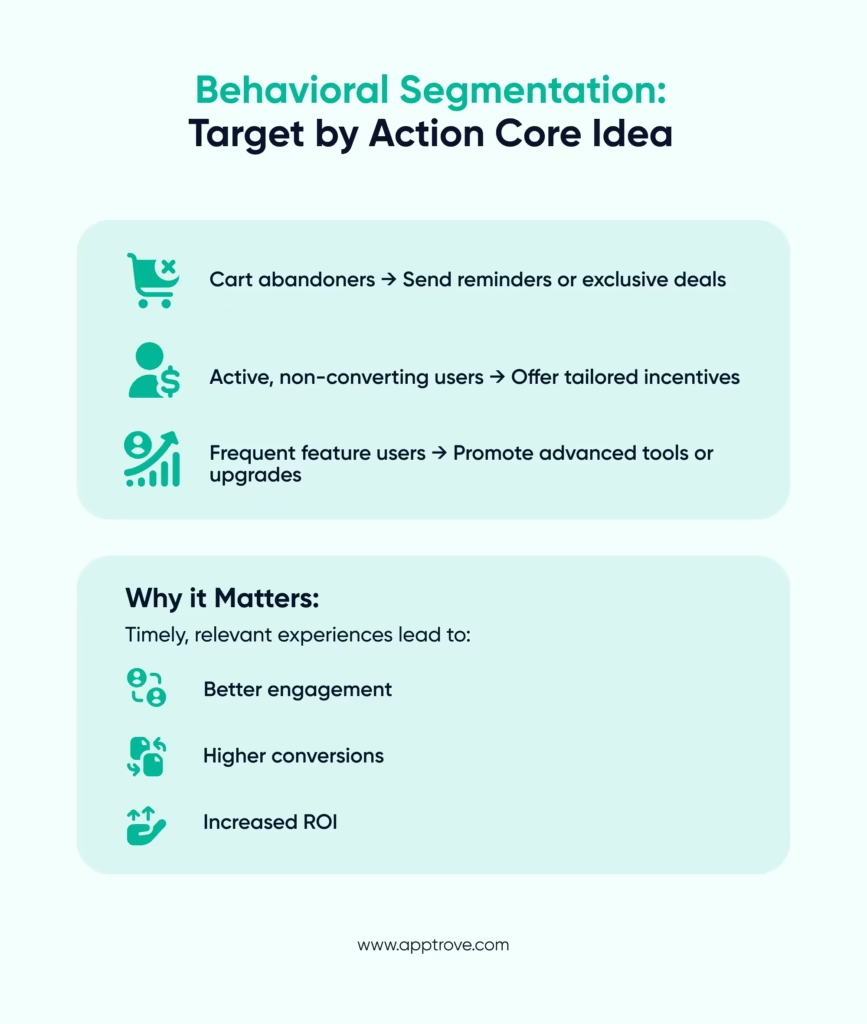
Behavioral segmentation is centered on user behavior—their actions and responses to campaigns, features, or in-app experiences. This segmentation is particularly effective due to the current representation of user intent and engagement.
For example, let’s say you target a segment of users who are abandoning their shopping cart in your experience. Behavioral segmentation will help you isolate that segment and offer intervention and relevancy to those users with reminders or a special deal. The same would be true for users who interact with your notifications a lot but have been unable to convert. You could offer them incentives that they would like based on their previous activity.
Analyzing behaviors regarding how users interact with features and the frequency of their sessions or responses to campaigns allows you to anticipate user needs. You have patterns of behavior established as a reference, and recognizing these patterns allows you to create experiences that are relevant and timely. Behavioral segmentation transforms activity and behavior into strategic decisions leading to improved engagement, conversions, and increased ROI.
Essential Behavioral Metrics to Consider
To really develop an effective behavioral segmentation plan, you will want to concentrate on metrics that give you some degree of orientation clarity, such as:
- Frequency of engagement: How often are users engaging with your app or particular features?
- Purchase patterns: Who are the segments that convert, how often, and in what manner?
- Responses to campaigns: What messages or notifications actually inspire a trigger of action?
- Signals of churn: What user behaviors lend themselves to foreshadowing a dampening of interest?
Considering these metrics will help you create hyper-relevant campaigns, predict needs, and provide experiences that feel targeted to the individual user. This is the level of precision that identifies advertising that is merely promoting the product and a higher tier of marketing that is growth-inducing.
Demographic Segmentation: Understanding Your Users in Addition to the Data
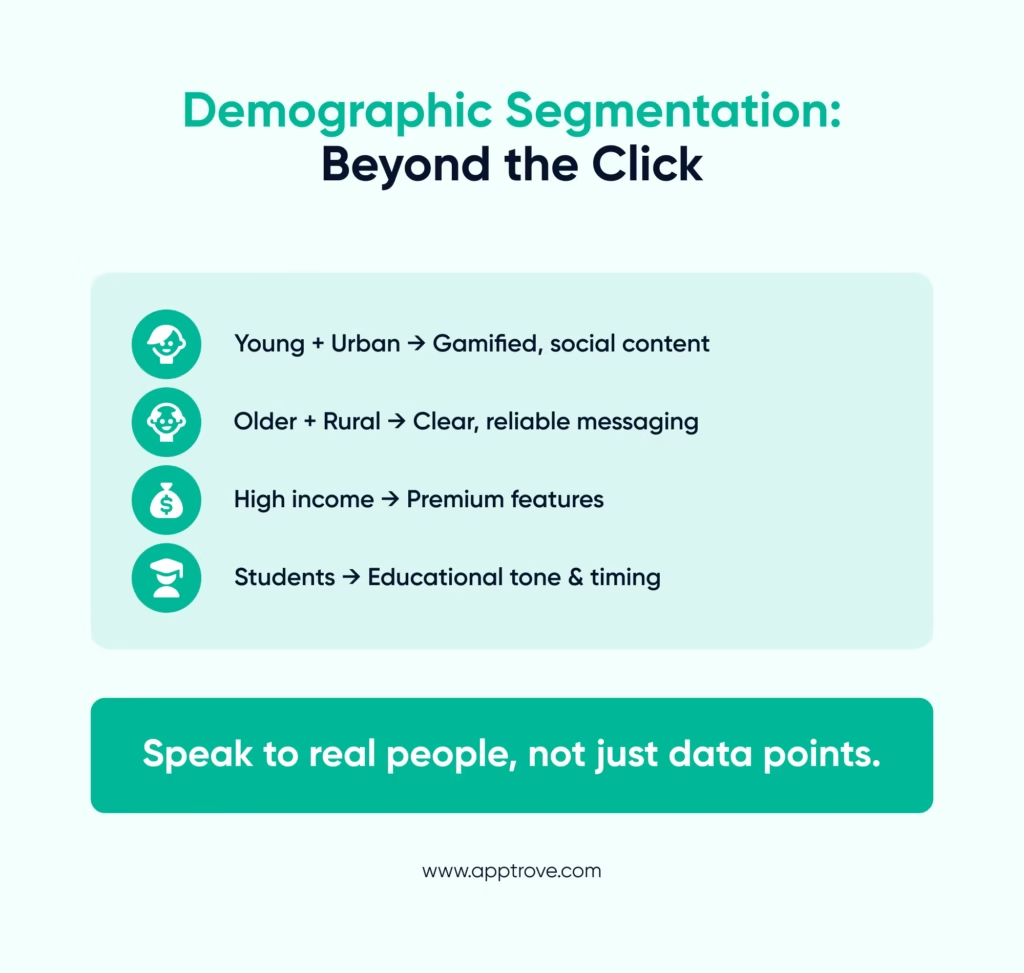
Behavioral data informs what your users do, while demographics tell you who your users are. The makeup of your user population – attributes such as age, gender, income, education, geographical location, or even the type of experience on their device – provides important context that contributes to user behaviors, attitudes, and engagement patterns, which can help you establish true connections with them, in order to create campaigns, experiences, and features that speak to each segment.
For example, younger users may enjoy more gamified experiences, interactive content, or social sharing opportunities. Older users might want usability, clarity and reliability. Users from cities might be more inclined to respond to offers that are location-based, while users from smaller towns might prefer a more no-frills, straightforward narrative. Combining demographic knowledge with user behavioral data will help you build campaigns that are personal, relevant, and timely.
Demographic segmentation is powerful because it can add further contextual detail to your behavioral insights. You may have a group of users who frequent push notifications. But, once you overlay demographics on top of this grouping, you may realize that they are actually high-value users aged 25-34 in metropolitan regions with a history of preferring evening engagement. With this knowledge, not only will you be able to schedule campaigns at times when the likelihood of users being active is increased, but you can tailor your messaging based on their lifestyle and deliver offers that become more contextualized based on their physical world experience.
Demographic segmentation also allows you to find new areas for growth. If you look at adoption rates through segments related to ages or regions, you may uncover previously underserved segments that could be developed into targeted campaigns. Income data will assist you in identifying the proper pricing and premium features where you can ethically deliver maximum monetization without alienating lower-income users. Likewise, education or work-related information can help tailor your content preferences, tone of messaging, and product positioning.
By layering demographic and behavioral data together, you will have a holistic view of your audience. This multidimensional viewpoint helps you become efficient with your campaigns that not only should be relevant, but also possibly increase the likelihood of long-term retention and lifetime value. You no longer will be making guesses about who your users are; you will be taking a more strategic approach based on patterns, context, and insights from the real world.
Developing a Successful Segmentation Strategy
When developing a segmentation strategy, it’s better to begin with clarity about your strategy and purpose. Ask yourself: what are you trying to achieve with segmentation? Are you trying to drive retention? Increase engagement? Increase revenue? Increase customers in a brand new market? Your objectives will help clarify what segments you are creating, what data you will be collecting, and how you will run your campaigns.
The next step is to gather data and analyze it. Get useful and actionable data, not everything. Look for any identifiable patterns that distinguish one segment from another and consider both behavioral and demographic signals. Segmentation is not about labeling users; it’s about recognizing how different groups behave and how you can serve them better.
Implementation is where strategy becomes action. You’ll want to tailor campaigns, features, and experiences for each segment. Timing, messaging, and the type of content will matter in each segment. For example, a user focused on short-form content may respond better to quick and actionable push notifications than to longer forms of tutorials or recommendations, while a user who engages with a collection of in-app resources may prefer a few in-depth tutorials or detailed recommendations.
Segmentation is an ongoing process. Your users change, the market changes, and their preferences change. You’ll want to continuously assess engagement, conversion, and retention metrics to better define your segments. You will also want to avoid key pitfalls such as over-segmenting into so many segments that you lose focus, or violating privacy to the users’ detriment and eroding their sense of agency. A good segmentation approach gets to the right length of granularity and still provides a clearly actionable agenda.
Measuring the Effects of Segmentation on Growth
You can extract value from segmentation only if you can measure the effects it has. Key measures will include engagement, conversion, retention, and return on investment (ROI). By tracking these measures, you can discover which segments are increasing in growth and which have fallen flat.
If you are monitoring engagement metrics, then you can see what users are doing with your app, features and campaigns. Segments with high engagement metrics clearly indicate you have found ways to connect and inspire them with your messaging. Segments with a low engagement metric probably need to be inspired to act and need more intervention.
The conversion metrics will show you which users engage with desired marketing outcomes (conversions) such as purchases and subscriptions. You can use conversion metrics to better understand where to start your marketing segmentation campaigns.
Retention metrics will show user engagement over time in order to see which segments continue to be active and which are in danger of churning.
With the availability of tools and analytics platforms, it is possible to track segment performance continuously, in real-time. By analyzing user behaviors, campaign responses, and purchase behaviors, it’s not only easy to change or enhance segmentation, but you can optimize segments on an ongoing basis. For instance, if you have one segment that constantly engages with personalized sales offers, you may want to increase the frequency of those targeted promotions. Conversely, if another segment continues to engage in higher degrees, segment responses may evolve. Consequently, you may want to reflect upon interventions like onboarding email refreshers or introducing in-app tutorials.
The segmentation webinar allows you to discriminate and measure your return on investment (ROI) much more extensively. Rather than evaluating campaigns overall, you can assess which segments are yielding you the highest lifetime values, while reallocating budgets much more effectively by segregating assays along your entire campaign development. This allows you to more efficiently spend marketing dollars where they count the most, and confidently apply ROI on stated metrics over time, which will yield compounding efficiency for additional growth sustainably.
Anticipated Future of Segmentation in a Privacy-First World
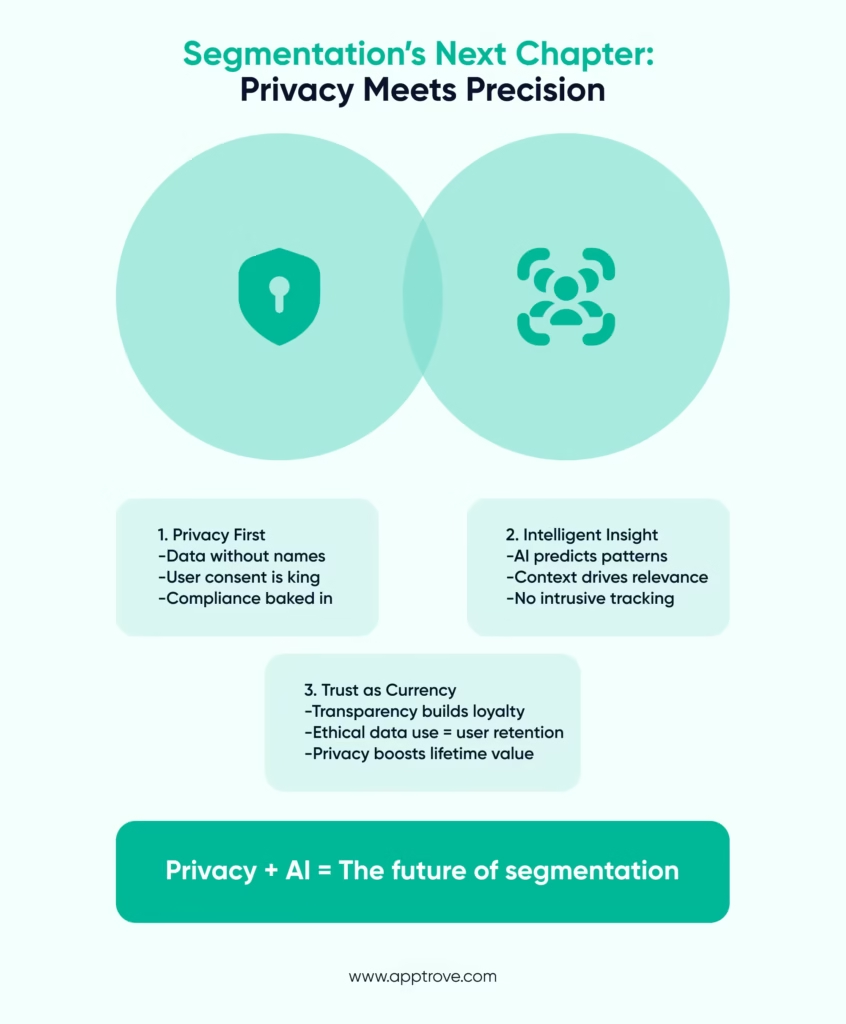
With the changing landscape of digital marketing, you can expect to see data privacy concerns at the forefront of emerging legislation. Existing regulations from GDPR, Local CCPA and several frameworks in different countries force marketers to adopt a privacy-first approach while continuing to provide personally relevant engagement. Likewise, rethinking traditional segmentation approaches will be needed to stay compliant while driving growth.
The modern approach uses AI-driven analytics and predictive model techniques to infer insights without having to provide personally identifiable information. Instead of relying on the identifiers or intrusive tracking, privacy-compliant frameworks help you understand trends, preferences and behaviours at an aggregate and/or anonymized level. This way, you will be able to segment your target audience appropriately while honouring their right to privacy.
Using privacy-minded segmentation galvanizes user trust, and users are more likely to interact with apps and campaigns that demonstrate ethical data utilization—trust begets loyalty that results in less churn and greater lifetime value. Marketers who adopt privacy-minded segmentation can still provide personalized engagements, predictive analytics of user behavior, and tailored campaigns.
In practice, this means creating segmentation models that prioritize consent, anonymize sensitive data, and base segmentation on behavioral and contextual insights rather than invasive, personal data. Alternatively, predictive models can predict user needs and help you to curate personalized experiences without compromising on privacy. The future of segmentation is based on insight, personalization, and privacy—creating value for marketers and users alike.
Conclusion: Segmentation that Works
Segmentation is not a tactic; it is a mindset that helps you understand users, identify opportunities and create personalized experiences. When you have insight about your customers, an understanding of the market, and an awareness of behaviours and the demographics around them, you can build what increases engagement, retention, and ultimately revenue.
To see what this looks like in a more tangible way, check out the Audience Segmentation techniques provided by AppTrove. It has handy utilities that segment users based on tangible behaviours, in-app activity or lifestyle stage, providing tailored experiences immediately.
Segmentation is a process that needs to be repeated and repeated. Markets change, your audience will grow and your data may tell you something different. By testing segments, optimizing campaigns, and responding to changed behaviour, you can ensure that your marketing is accurate, meaningful and measurable.
An important part of this process is A/B testing. When you put together segmentation and A/B testing, you will get affirmation of what resonates best with the audience types – messaging, presentation of features, or offers. The cycle of experimentation will lead to stronger insights and better outcomes.
When done correctly, segmentation can make generic campaigns targeted, casual users fans, and lessen your marketing from being a guess to a plan. It gives clarity, confidence, and actionable intelligence for every decision you make.
It’s time to embrace segmentation. In this way, you will create the best possible use of your audience and research, be more precise with your marketing strategy, and position your app for continued growth in an ever-expanding, competitive, digital-first marketplace.
Learn about how to enable segmentation to work with your app at Apptrove.
